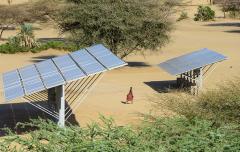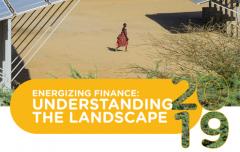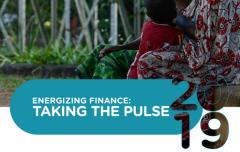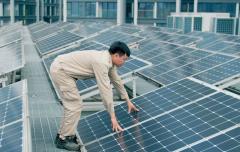Off-grid solar solutions: The pathway to 100 percent electrification in the Philippines
The Philippines has been identified as one of the 20 high-impact countries (HICs) whose efforts to increase access to electricity, as well as clean cooking, can make the most difference on a global scale to achieve universal electricity access by 2030.
Because of its high urbanization rate, nearly 90 percent of households in the Philippines have access to electricity. The government has set a 100 percent electrification target by 2020 in its 2016-2030 energy plan. How can electricity sector investment help a country spread over 7,100 islands deliver on this target and provide electricity access to the hardest to reach populations?
The Energizing Finance: Taking the Pulse 2019 country study on the Philippines highlights projected financing needs for universal energy access by 2030. The report envisions grid and off-grid solutions both playing roles in achieving universal access, with off-grid solutions complementing grid extension and densification in electrifying the whole archipelago.
The critical role of stand-alone systems
Of the total USD 36 billion tracked for electrification in the HICs in 2017 – identified in Energizing Finance: Understanding the Landscape 2019 – only USD 12.6 billion was directed to electrifying households. And only 1.2 percent of the total amount was committed for off-grid electricity solutions, which will be critical for providing last-mile access and with it the basics of a modern household, improved resilience and economic development opportunities.
This is especially true for the Philippines where off-grid solutions – stand-alone solar and mini-grids – are instrumental, as the most cost-effective way to provide energy access, especially to the last 10 percent of the population who live without electricity in rural, island areas.
Taking the Pulse analysis demonstrates that in the past 15 years, renewable energy generation in the country has remained stagnant, representing 23 percent of total power supply. Conversely, coal-fired power more than tripled over the same period to account for 52 percent of the Philippines’ power supply, including almost 5MW in new coal-fired generation capacity in 2019.
Yet, there are also positive examples for off-grid and mini-grids deployment in the archipelago (e.g. Romblon’s success story featured in this video by the Institute for Climate and Sustainable Cities). Financial projections from the Taking the Pulse report confirm that such solutions can be extended to achieve universal electricity access if an adequate regulatory framework is put in place and a total of USD 1.25 billion invested by 2030.
In some rural areas, people are now able to afford electricity generated by mini-grids thanks to a national government subsidy scheme for households that helps close the affordability gap. Taking the Pulse projections anticipate that 1.25 million households can be reached through mini-grid generated electricity by 2030 if USD 354 million is invested in mini-grids between now and then. Despite its promising future, investors haven’t yet seized the opportunity, with no finance commitments for mini-grids identified in the Philippines in 2017.
Closing the access gap
Taking the Pulse forecast scenario also envisages stand-alone solar will account for 2.5 million household connections over the 2020-2030 period (or 35 percent of new connections over the period). This will require USD 897 million in finance of which USD 33 million would be utilized to address the affordability gap and provide electricity service to the most marginalized and vulnerable households. This is in staggering contrast with the mere USD 3 million in finance commitments for stand-alone solar tracked in the Philippines in 2017.
National stakeholders in the Philippines and international finance will need to innovate to create new financing solutions – including public-private approaches – and to deliver power to isolated populations in low-density areas. Taking the Pulse proposes recommendations for the government to boost investment towards off-grid solutions and encourage broader private sector participation in the electricity sector:
- Establish a new regulatory process that simplifies business registration and facilitates access to subsidies for small-scale mini-grids projects.
- Improve data collection to develop in-depth and up-to-date market information that offers intelligence for stand-alone solar players and consumers.
- Adjust electricity tariffs structures to provide a clear cost incentive for utilities to transition towards cleaner energy technologies. Utility companies should not be able to pass the fluctuating costs of imported fossil fuels and foreign exchange directly to consumers.
When it comes to access to clean cooking, the challenge will require much greater commitment. More than 17 million households in the Philippines still lack full access to clean cooking solutions. The Taking the Pulse country study finds that USD 1.8 billion is required between now and 2030 to close the access gap for both off-grid electricity and improved cooking solutions in the Philippines.
Read the full report and the Philippines country study, and follow #SDG7Finance for the latest.
Energizing Finance: Taking the Pulse 2019 was developed in partnership with Catalyst Off-Grid Advisors and E3 Analytics.
HICs: 20 developing countries in Sub-Saharan Africa and Asia with some of the world’s largest energy access deficits and that together are home to nearly 80 percent of those living without access—referred to as the high-impact countries (HICs). The list of HICs is taken from the 2015 Global Tracking Framework, which was the most up to date list at the time 2017 Energizing Finance was commissioned and maintained in the 2018, 2019 reports to ensure comparison across years.
For electricity access findings, the high-impact countries are Afghanistan, Angola, Bangladesh, Burkina Faso, Congo (DR), Ethiopia, India, Kenya, Korea (DPR), Madagascar, Malawi, Mozambique, Myanmar, Niger, Nigeria, Philippines, Sudan, Tanzania, Uganda, and Yemen.
For clean cooking access findings, the high-impact countries are Afghanistan, Bangladesh, China, Congo (DR), Ethiopia, India, Indonesia, Kenya, Korea (DPR), Madagascar, Mozambique, Myanmar, Nepal, Nigeria, Pakistan, Philippines, Sudan, Tanzania, Uganda, and Vietnam.
Photo credit: Asian Development Bank




